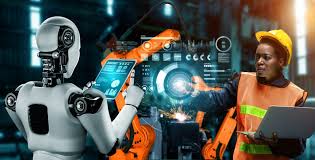The field of robotics is advancing rapidly, with innovations in artificial intelligence (AI), machine learning, and automation transforming the way industries operate. Robotics, once primarily limited to manufacturing floors, is now branching out into virtually every sector, including healthcare, logistics, agriculture, and even services. Over the next decade, robotics is poised to revolutionize industries, leading to unprecedented changes in productivity, efficiency, and the way work is carried out.
In this article, we’ll explore how robotics is expected to revolutionize different industries in the coming years, the challenges that come with this transformation, and the potential benefits and risks that businesses and societies will face as robotics continues to evolve.
1. The Role of Robotics in Industry Today
Robots have already made a significant impact in various industries. In manufacturing, for example, robots are used for tasks such as assembly, packaging, and quality control, which were traditionally performed by humans. These robots can operate at high speeds and precision, leading to increased productivity and fewer human errors.
In logistics, robots and automated systems are already transforming supply chains, warehousing, and delivery systems. Autonomous mobile robots (AMRs) and drones are improving the speed and accuracy of deliveries, while automated guided vehicles (AGVs) are streamlining warehouse operations.
While robotics is already contributing to a wide range of industries, its potential for the future is even more transformative, with the technology advancing at a rapid pace.
2. How Robotics Will Revolutionize Different Industries in the Next Decade
Manufacturing and Automation
One of the industries most dramatically impacted by robotics is manufacturing. The next decade will see even more advanced robotics integrated into the manufacturing process, drastically improving efficiency and lowering costs.
Smart Factories and Collaborative Robots (Cobots)
In the coming decade, manufacturing will increasingly rely on smart factories, where robots, AI, and the Internet of Things (IoT) work together to optimize production lines. These factories will be highly automated, with robots collaborating with human workers (known as cobots) to complete complex tasks.
Cobots are designed to work alongside humans safely and efficiently. In contrast to traditional industrial robots that work in isolation, cobots can adjust to their environment and adapt to human movement, helping with assembly, quality checks, and material handling. This collaborative approach will not only increase production but also reduce worker strain by automating the most labor-intensive tasks.
Healthcare and Surgery
Robotics in healthcare is already making significant strides, and its potential in the next decade is immense. In the field of surgery, robot-assisted surgery is becoming increasingly common, with systems like the da Vinci Surgical System already enabling surgeons to perform minimally invasive procedures with greater precision and control.
Robotic-Assisted Surgery and Diagnostics
The next decade will likely see the development of more advanced robotic surgery platforms that allow surgeons to operate with even greater precision, potentially reducing the risk of complications, minimizing recovery time, and improving patient outcomes. Robotics will also aid in diagnostics, with AI-powered robots capable of analyzing medical images, predicting patient outcomes, and providing decision support to doctors.
In addition, robots could play a more prominent role in elder care, assisting elderly people with daily tasks, providing companionship, and even remotely monitoring health conditions. These robots could be equipped with AI systems to detect early signs of diseases like dementia or Parkinson’s and offer proactive care.
Logistics and Supply Chain
The logistics and supply chain industry is experiencing a significant transformation driven by robotics, and this is expected to accelerate in the next decade. With the growing demand for faster and more efficient deliveries, robots will become integral in warehousing, inventory management, and last-mile delivery.
Autonomous Delivery Vehicles and Drones
Autonomous delivery vehicles and drones are set to revolutionize last-mile logistics. Companies like Amazon and UPS are already experimenting with drone delivery systems, which will enable faster deliveries, especially in urban areas. In the next decade, we can expect the widespread deployment of delivery drones and ground-based autonomous vehicles, which will speed up the delivery process and reduce operational costs.
Furthermore, automated warehouses will become even more efficient as robots take over repetitive tasks such as sorting, packaging, and inventory management. These robots will operate 24/7, leading to increased efficiency and reduced human error. For example, Amazon’s warehouse robots are already improving storage capacity and order fulfillment times, and we can expect other companies to adopt similar technologies.
Agriculture and Food Production
Robotics is poised to revolutionize agriculture by addressing the challenges of labor shortages, increasing efficiency, and ensuring more sustainable food production. In the next decade, robots will play a central role in farming, from planting and harvesting crops to monitoring plant health.
Automated Farming Systems
One of the most promising applications of robotics in agriculture is autonomous farming equipment. Self-driving tractors, combine harvesters, and drones will become more sophisticated, allowing farmers to plant, monitor, and harvest crops with minimal human intervention. These robots will be able to operate in various weather conditions and at times of day when human labor is unavailable, leading to higher productivity.
Additionally, precision agriculture will benefit from robotics, with robots capable of detecting plant diseases, applying fertilizers or pesticides with pinpoint accuracy, and monitoring soil health. By reducing waste and ensuring that resources are used efficiently, these technologies will help to address the challenges of food security while minimizing environmental impact.
Retail and Customer Service
Robotics will also play an increasingly significant role in the retail and customer service industries, automating tasks that were once performed by humans.
Robotic Store Assistants and Self-Checkout Systems
Retailers are already introducing robotic assistants to improve customer service. These robots can guide customers to products, answer questions, and assist with inventory management. In the next decade, we will likely see more widespread use of humanoid robots in stores, particularly in customer-facing roles.
In addition, self-checkout systems powered by AI and robotics will become even more advanced, enabling customers to check out quickly without the need for human cashiers. These systems will not only improve the customer experience but also reduce operational costs for retailers.
Construction and Infrastructure
The construction industry, which has traditionally been slow to adopt new technologies, is poised for a major shift thanks to robotics. From 3D printing buildings to automated bricklaying, robots will increasingly handle tasks that are repetitive or dangerous for human workers.
Robotic Construction Systems and 3D Printing
In the next decade, we can expect to see robotic systems being used to construct buildings faster and more efficiently. 3D printing technology, in particular, has the potential to radically change construction by enabling the printing of entire structures with fewer resources and less waste. Robots will also play a role in tasks such as demolition, site clearing, and the installation of infrastructure components, reducing the time and cost involved in construction projects.
Furthermore, robots will enhance safety in the construction industry by performing dangerous tasks such as lifting heavy objects, working at great heights, or operating in hazardous environments. This will reduce the risk of workplace injuries and fatalities.
Education and Training
Robotics is already making its way into the education sector, and in the next decade, we can expect to see a more significant integration of robots in the classroom. From helping students with special needs to providing personalized tutoring, robots can play a transformative role in education.
Educational Robots and Virtual Learning Assistants
Robotic tutors could offer personalized learning experiences for students, adapting lessons based on individual learning speeds and styles. These robots could assist with tasks like teaching coding, providing feedback on assignments, and even guiding students through complex subjects such as math and science.
Furthermore, virtual learning assistants powered by AI and robotics can assist teachers by automating administrative tasks, grading assignments, and helping with remote learning. As education becomes more technology-driven, robots will help improve learning outcomes and make education more accessible to students worldwide.
3. Challenges and Ethical Considerations
While the potential benefits of robotics are clear, there are several challenges and ethical considerations that need to be addressed:
Job Displacement and Automation
One of the most significant concerns about the widespread use of robots in industries is job displacement. As robots take over repetitive, dangerous, or labor-intensive tasks, many workers in these roles may lose their jobs. Industries must carefully manage this transition by upskilling the workforce and creating new opportunities for employment in areas like robotics maintenance, programming, and supervision.
Safety and Reliability
As robots become more integrated into various sectors, ensuring their safety and reliability is crucial. Robots must be able to function autonomously without posing risks to human workers or consumers. This includes developing systems that allow robots to work alongside humans safely, with appropriate safeguards in place to prevent accidents.
Ethical and Legal Concerns
Robotics also raises ethical questions, especially when it comes to decision-making in critical fields like healthcare and autonomous vehicles. How much control should be given to robots in life-and-death situations, and how can accountability be assigned in cases of failure? There will need to be clear legal and ethical guidelines to govern the use of robotics, especially in sectors that directly affect people’s lives.
4. The Future of Robotics
The next decade promises a world where robotics will reshape virtually every industry, improving efficiency, productivity, and safety. With advancements in AI, machine learning, and automation, robotics will become an integral part of industries from healthcare and manufacturing to logistics, construction, and beyond.
The challenges of job displacement and ethical concerns must be addressed through thoughtful planning and policy-making, ensuring that the benefits of robotics are equitably distributed. By embracing innovation and preparing the workforce for these changes, industries can harness the transformative potential of robotics, driving progress and improving the quality of life for people around the world.
Conclusion
In the next decade, robotics will continue to revolutionize industries, driving unprecedented change and improvements in efficiency, safety, and productivity. From manufacturing and healthcare to logistics and construction, robotics has the potential to streamline operations, reduce costs, and create new opportunities. However, it will be crucial for businesses, policymakers, and society to navigate the challenges associated with automation, including job displacement, safety concerns, and ethical considerations. With the right approach, robotics can play a pivotal role in shaping a more innovative and sustainable future.

